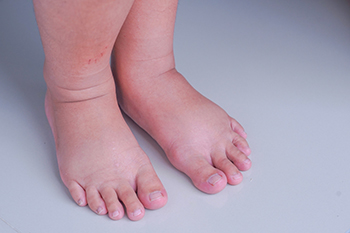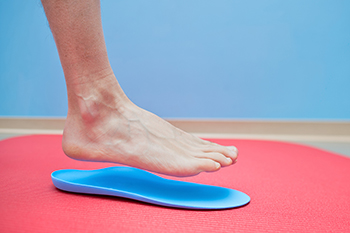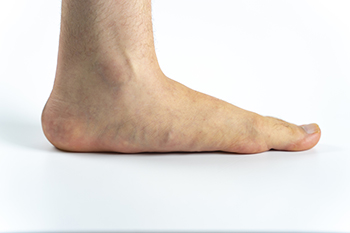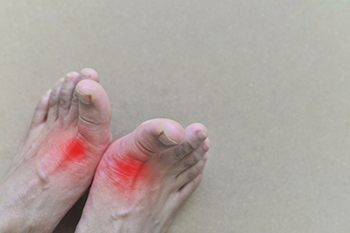
Cedarhurst (516) 374-3668
Franklin Square (516) 775-8440

Cedarhurst (516) 374-3668
Franklin Square (516) 775-8440

The body can provide hints to alert people that something potentially serious is going on in their bodies. Such signals take on different forms depending on the health issue experienced. Swelling of the feet is one such symptom that can be a flag of health problems. Peripheral edema, the term used to refer to swollen feet, is a gathering of fluid within the tissue of the feet. Swollen feet can be caused by prolonged periods of inactivity, walking for a long time, or hot, humid weather. They also can be caused by more serious underlying health conditions. Foot injuries, such as sprains and fractures often cause swelling. Lymphedema, when the lymphatic system is compromised and there is inefficient draining of fluid that collects in the lower limbs, can cause swelling in the feet. Osteoarthritis is a degenerative joint disease caused by wear and tear on joints and the breakdown of cartilage that can lead to the feet becoming swollen. Besides the fact that our feet are the source of our mobility, other health issues may be lurking behind swollen feet so taking care of them is critical. If you are experiencing prolonged swelling in your feet, it is suggested you see a podiatrist for a proper diagnosis and treatment.
Swollen feet can be a sign of an underlying condition. If you have any concerns, contact Robert Stein, DPM of South Shore Foot Care. Our doctor can provide the care you need to keep you pain-free and on your feet.
Swollen feet are a common ailment among pregnant women and people who stand or sit for extended periods. Aging may increase the possibility of swollen feet and patients who are obese often notice when their feet are swelling too. There may be medical reasons why swollen feet occur:
Swollen feet can also be caused by bone and tendon conditions, including fractures, arthritis, and tendinitis. Additionally, there may be skin and toenail conditions and an infection may cause the feet to swell. Patients who take medicine to treat high blood pressure may be prone to getting swollen feet.
Many patients elevate their feet to help relieve the swelling and this is generally a temporary remedy. When a podiatrist is consulted the reason behind the swelling can be uncovered and subsequently treated.
If you have any questions please feel free to contact our offices located in Cedarhurst and Franklin Square, NY . We offer the newest diagnostic tools and technology to treat your foot and ankle needs.

Podiatrists often prescribe orthotics that may help various foot conditions. The joints in the feet and ankle undergo stress while walking and running, and wearing orthotics may help to relieve some of this pressure. Many patients have found they are able to walk or run faster, and this may be a result of the shock absorption that can come from wearing orthotics. Diabetic patients can benefit from wearing orthotics, which may help to prevent injuries that can happen from the inability to feel nerve damage. Additionally, orthotics may help to distribute the body’s weight evenly, possibly preventing corns and calluses from developing. If you have any type of foot condition, it is strongly suggested that you are under the care of a podiatrist who can determine if orthotics are right for you.
If you are having discomfort in your feet and would like to try orthotics, contact Robert Stein, DPM from South Shore Foot Care. Our doctor can provide the care you need to keep you pain-free and on your feet.
What Are Orthotics?
Orthotics are inserts you can place into your shoes to help with a variety of foot problems such as flat feet or foot pain. Orthotics provide relief and comfort for minor foot and heel pain but can’t correct serious biomechanical problems in your feet.
Over-the-Counter Inserts
Orthotics come in a wide variety of over-the-counter inserts that are used to treat foot pain, heel pain, and minor problems. For example, arch supports can be inserted into your shoes to help correct overarched or flat feet, while gel insoles are often used because they provide comfort and relief from foot and heel pain by alleviating pressure.
Prescription Orthotics
If over-the-counter inserts don’t work for you or if you have a more severe foot concern, it is possible to have your podiatrist prescribe custom orthotics. These high-quality inserts are designed to treat problems such as abnormal motion, plantar fasciitis, and severe forms of heel pain. They can even be used to help patients suffering from diabetes by treating foot ulcers and painful calluses and are usually molded to your feet individually, which allows them to provide full support and comfort.
If you are experiencing minor to severe foot or heel pain, it’s recommended to speak with your podiatrist about the possibilities of using orthotics. A podiatrist can determine which type of orthotic is right for you and allow you to take the first steps towards being pain-free.
If you have any questions please contact our offices located in Cedarhurst and Franklin Square, NY . We offer the newest diagnostic and treatment technologies for all your foot and ankle needs.

Flat feet happen when the feet are flush with the ground. Sometimes flat feet can contribute to foot, ankle, or knee problems because they can alter leg alignment. Flat feet can be a result of overuse injuries, excess weight, a bone deformity, or a tendon tear or rupture. Sometimes flat feet are genetic. There are no gender differences for risk of flat feet. A person with flat feet may not be allowed in the military because spinal damage can happen to such a person when marching. Having flat feet can also cause overpronation in runners. Flat feet can also interfere with proper balance as body weight is unevenly distributed and present more of a risk for falling. Orthotics, braces, or insoles might help flat feet. If there is no pain, treatment for flat feet is not needed. If you have flat feet and they are causing discomfort, see a podiatrist who can examine your feet and provide options to address your symptoms.
Flatfoot is a condition many people suffer from. If you have flat feet, contact Robert Stein, DPM from South Shore Foot Care. Our doctor will treat your foot and ankle needs.
What Are Flat Feet?
Flatfoot is a condition in which the arch of the foot is depressed and the sole of the foot is almost completely in contact with the ground. About 20-30% of the population generally has flat feet because their arches never formed during growth.
Conditions & Problems:
Having flat feet makes it difficult to run or walk because of the stress placed on the ankles.
Alignment – The general alignment of your legs can be disrupted, because the ankles move inward which can cause major discomfort.
Knees – If you have complications with your knees, flat feet can be a contributor to arthritis in that area.
Symptoms
Treatment
If you are experiencing pain and stress on the foot you may weaken the posterior tibial tendon, which runs around the inside of the ankle.
If you have any questions please feel free to contact our offices located in Cedarhurst and Franklin Square, NY . We offer the newest diagnostic and treatment technologies for all your foot and ankle needs.

There is a portion of tissue on the bottom of the foot that is called the plantar fascia. It connects the heel to the toes and is instrumental in helping the foot flex while walking, running, and completing other daily activities. An injury may cause the plantar fascia to tear, possibly resulting in plantar fasciitis. It may also occur from overuse that can happen from running or standing on uneven surfaces. Plantar fasciitis is an inflammation that can cause severe pain and discomfort, and may affect the Achilles tendon in the calf. It may also be caused by wearing shoes that do not fit correctly, having an abnormal foot structure, or from weight that has been gained. Common symptoms may include foot pain after sitting or standing for a long period of time, and difficulty in climbing the steps. Additionally, the pain may be more severe after arising in the morning, as the first few steps are taken. If you have foot pain, it is strongly urged that you are under the care of a podiatrist who can accurately diagnose plantar fasciitis, and guide you toward the correct treatment techniques.
Plantar fasciitis can be very painful and inconvenient. If you are experiencing heel pain or symptoms of plantar fasciitis, contact Robert Stein, DPM from South Shore Foot Care. Our doctor can provide the care you need to keep you pain-free and on your feet.
What Is Plantar Fasciitis?
Plantar fasciitis is the inflammation of the thick band of tissue that runs along the bottom of your foot, known as the plantar fascia, and causes mild to severe heel pain.
What Causes Plantar Fasciitis?
How Can It Be Treated?
While very treatable, plantar fasciitis is definitely not something that should be ignored. Especially in severe cases, speaking to your doctor right away is highly recommended to avoid complications and severe heel pain. Your podiatrist can work with you to provide the appropriate treatment options tailored to your condition.
If you have any questions please feel free to contact our offices located in Cedarhurst and Franklin Square, NY . We offer the newest diagnostic and treatment technologies for all your foot and ankle needs.

Gout, a form of arthritis, is a painful foot condition caused by excess uric acid in the blood, and it may happen from having a genetic disposition to it. It may also occur from eating foods, such as shellfish and red meat, that have large amounts of purines. Also, diabetic patients and people who have a kidney disorder may be prone to developing gout, and it is beneficial for these people to pay extra attention to the type of foods that are eaten. The pain commonly occurs in the joints of the big toe as a result of crystals that become lodged there from excess purines. The symptoms associated with gout can include debilitating pain, swelling, and the affected joints can become inflamed. Many people have difficulty in walking, and prompt medical attention is often sought. If you suffer from gout, please consult with a podiatrist who can help you to manage this condition.
Gout is a foot condition that requires certain treatment and care. If you are seeking treatment, contact Robert Stein, DPM from South Shore Foot Care. Our doctor will treat your foot and ankle needs.
What Is Gout?
Gout is a type of arthritis caused by a buildup of uric acid in the bloodstream. It often develops in the foot, especially the big toe area, although it can manifest in other parts of the body as well. Gout can make walking and standing very painful and is especially common in diabetics and the obese.
People typically get gout because of a poor diet. Genetic predisposition is also a factor. The children of parents who have had gout frequently have a chance of developing it themselves.
Gout can easily be identified by redness and inflammation of the big toe and the surrounding areas of the foot. Other symptoms include extreme fatigue, joint pain, and running high fevers. Sometimes corticosteroid drugs can be prescribed to treat gout, but the best way to combat this disease is to get more exercise and eat a better diet.
If you have any questions please feel free to contact our offices located in Cedarhurst and Franklin Square, NY . We offer the newest diagnostic and treatment technologies for all your foot and ankle needs.

A well-fitting shoe is the most important consideration when selecting shoes for an aging foot. Seniors should be particularly mindful of having their feet measured when they buy shoes as the foot changes as aging occurs. The arch can fall, and the foot can become longer and wider. Issues with the forefoot are common in seniors and properly fit shoes, with sufficient room in the toe box, will help in preventing pain in this area as well as problems with toenails and bunions. Shoe quality varies by brand and just because a shoe fits in one size with one brand or model does not mean it will when considering another brand or model. Visiting a podiatrist is helpful in understanding the right shoes for your feet as you age.
Proper foot care is something many older adults forget to consider. If you have any concerns about your feet and ankles, contact Robert Stein, DPM from South Shore Foot Care. Our doctor can provide the care you need to keep you pain-free and on your feet.
The Elderly and Their Feet
As we age we start to notice many changes in our body, but the elder population may not notice them right away. Medical conditions may prevent the elderly to take notice of their foot health right away. Poor vision is a lead contributor to not taking action for the elderly.
Common Conditions
Susceptible Infections
Diabetes and poor circulation can cause general loss of sensitivity over the years, turning a simple cut into a serious issue.
If you have any questions please feel free to contact our offices located in Cedarhurst and Franklin Square, NY . We offer the newest diagnostic and treatment technologies for all your foot and ankle needs.

Having foot surgery performed is often a decision that is made when milder treatments have not worked. A bunion can increase in size when it is left untreated, and surgery may be necessary for permanent removal. Having bunion surgery done will realign the joint in addition to relieving existing pain. Patients who are afflicted with arthritis may opt to have fusion surgery performed, which is generally successful in joining the bones together which may eliminate the pain. Morton’s neuroma is a condition that causes the nerve between the third and fourth toes to become inflamed and irritated. In severe cases, surgery is performed that can repair or remove the affected nerve. A broken toe may need surgery if the fracture is severe, and the bone protrudes through the skin. Additionally, toe surgery can be done to repair a dislocated toe, which can happen from an injury. If you have foot pain and would like to know more about the options for foot surgery, please confer with a podiatrist who can inform you of the correct choices.
Foot surgery is sometimes necessary to treat a foot ailment. To learn more, contact Robert Stein, DPM of South Shore Foot Care. Our doctor will assist you with all of your foot and ankle needs.
When Is Surgery Necessary?
Foot and ankle surgery is generally reserved for cases in which less invasive, conservative procedures have failed to alleviate the problem. Some of the cases in which surgery may be necessary include:
What Types of Surgery Are There?
The type of surgery you receive will depend on the nature of the problem you have. Some of the possible surgeries include:
Benefits of Surgery
Although surgery is usually a last resort, it can provide more complete pain relief compared to non-surgical methods and may allow you to finally resume full activity.
Surgical techniques have also become increasingly sophisticated. Techniques like endoscopic surgery allow for smaller incisions and faster recovery times.
If you have any questions please feel free to contact our offices located in Cedarhurst and Franklin Square, NY . We offer the newest diagnostic and treatment technologies for all your foot and ankle needs.

Sharp pain and redness in a toe where the nail meets the surrounding skin is usually caused by an ingrown toenail. In most cases, this condition is the result of improper trimming of the toenail which often affects the big toe. The sides of the nail can grow into the skin, and it can become red, sore, and painful. Wearing tight or rigid shoes and socks that restrict movement can worsen the pain. Additionally, the pain may increase if the nail becomes infected. If this occurs, it may ooze pus, and it is strongly suggested that you see a podiatrist at your earliest convenience. Depending on the severity of an ingrown toenail, it may be necessary to surgically remove part or all of the toenail. Medication to fight infection will likely be prescribed. Prevention of an ingrown toenail involves cutting the toenails straight across, keeping the feet clean and dry, and wearing shoes that fit properly. For more information on treatment options, please consult a podiatrist.
Ingrown toenails may initially present themselves as a minor discomfort, but they may progress into an infection in the skin without proper treatment. For more information about ingrown toenails, contact Robert Stein, DPM of South Shore Foot Care. Our doctor can provide the care you need to keep you pain-free and on your feet.
Ingrown Toenails
Ingrown toenails are caused when the corner or side of a toenail grows into the soft flesh surrounding it. They often result in redness, swelling, pain, and in some cases, infection. This condition typically affects the big toe and may recur if it is not treated properly.
Causes
You are more likely to develop an ingrown toenail if you are obese, have diabetes, arthritis, or have any fungal infection in your nails. Additionally, people who have foot or toe deformities are at a higher risk of developing an ingrown toenail.
Symptoms
Some symptoms of ingrown toenails are redness, swelling, and pain. In rare cases, there may be a yellowish drainage coming from the nail.
Treatment
Ignoring an ingrown toenail can have serious complications. Infections of the nail border can progress to a deeper soft-tissue infection, which can then turn into a bone infection. You should always speak with your podiatrist if you suspect you have an ingrown toenail, especially if you have diabetes or poor circulation.
If you have any questions, please feel free to contact our offices located in Cedarhurst and Franklin Square, NY . We offer the newest diagnostic and treatment technologies for all your foot care needs.
Every patient is unique and so are treatments. The information on this website is for educational purposes and each individual
patient care model may differ.